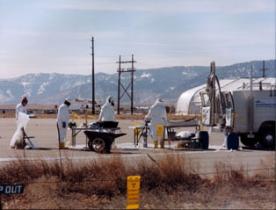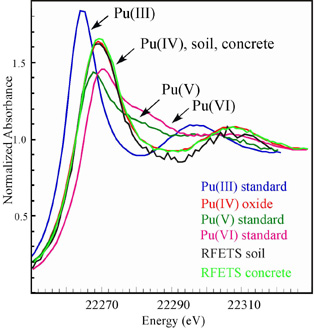
The Rocky Flats Environmental Technology Site (RFETS) is an environmental cleanup site located about 16 miles northwest of downtown Denver (Fig 1). Two decades of routine monitoring have shown that the environment around RFETS is contaminated with actinide elements (U, Pu, Am) from site operations, [1] and RFETS has been designated by the U.S. Environmental Protection Agency (EPA) as a Superfund cleanup site. Until December 1989, the Rocky Flats Plant made components for nuclear weapons using various radioactive and hazardous materials, including plutonium, uranium and beryllium. Nearly 40 years of nuclear weapons production left behind a legacy of contaminated facilities, soils, and ground water. More than 2.5 million people live within a 50 mile radius of the site; 300,000 of those live in the Rocky Flats watershed.
A massive accelerated cleanup effort began in 1995. The key priority of site management and surrounding community leaders is the safe, accelerated closure of Rocky Flats. Kaiser-Hill and the DOE, working in close coordination with Rocky Flats stakeholders, are working on a plan to substantially complete the cleanup and closure of Rocky Flats by the aggressive goal of 2006. The closure of Rocky Flats is estimated to cost between $6 billion and $8 billion. [2]

The spatial distribution of plutonium in RFETS soils has been estimated,[3,4] with plutonium activities in surface soils ranging from 1,450 to 0.05 pCi/g, with the data showing a clear west-east trend away from an old drum storage site known as the 903 Pad. [5] More than 90% of the Pu is contained within the upper 10-12 cm of soils downwind of the 903 Pad (Fig 2).
The transport of plutonium in the environment involves complex chemical and physical processes. The probability of release of plutonium from RFETS soils to the surrounding environment will be governed by the solubility of its compounds in groundwater and surface waters, the tendency of plutonium compounds to be adsorbed onto mineral phases in soil particles, and by the probability that the colloidal forms of plutonium will be filtered out by the soil or rock matrices, adsorb or settle out during transport, or be available for dispersal by prevailing winds. [6,7] Therefore, the chemical speciation (oxidation state, and chemical form) of the plutonium in soils and contaminated concretes at RFETS, and whether plutonium exists in a soluble or insoluble form is of great interest to the Site. This information and understanding is key to choosing proper remediation strategies, the correct model for assessing public health risks, and aiding decisions for future land configuration and management.
Steven Conradson and co-workers from Los Alamos National Laboratory examined X-ray absorption spectra at the plutonium LII edge on a series well-characterized standard compounds in oxidation states 0, III, IV, V, and VI, followed by samples of contaminated RFETS soils and concrete collected from the site. [8,9,10] These studies utilized the actinide facility at SSRL's new Molecular Environmental Science Beam Line 11-2.

For plutonium studies, researchers prefer to use the LIII x-ray absorption edge (near 18,060 eV) because of its high absorption intensity.[8] However, in RFETS environmental samples there are other elements (principally strontium) present in the natural minerals which exhibit x-ray emission in this same region, and therefore interfere with plutonium measurements. As a result, the plutonium x-ray absorption studies of RFETS samples were performed instead at the LII x-ray absorption edge (near 22,270 eV). A calibration experiment was run at both LIII and LII absorption edges using plutonium standards in oxidation states 0, III, IV, V, and VI. The LIII and LII XANES and XAFS spectra of the plutonium standards were nearly identical, giving high confidence in the use of the plutonium LII edge for study of RFETS environmental samples. A comparison of LII XANES spectra of plutonium standards in oxidation states III, IV, V, and VI, RFETS soil, and RFETS concrete exposed to contaminated smoke (from a building fire) is shown in Fig 3. From Fig 3, the Pu XANES spectra of the soil and concrete samples were not only clearly consistent with Pu(IV), but were identical within the experimental uncertainties to the PuO2 standard. The XANES measurements on RFETS samples clearly show that the oxidation state of plutonium is Pu(IV), and the XANES spectral signatures are very similar to that of PuO2 in both soil and concrete samples.

One of the soil samples was concentrated enough with respect to plutonium that XAFS data could be analyzed. XAFS curve fitting and data analysis revealed local structure features nearly identical to that for Pu in the solid PuO2 standard, the structure of which is illustrated in Fig 4, with one small exception. In addition to interatomic distances of 2.33 and 3.86 Å, the Fourier transforms from RFETS soil and concrete data show some small peaks at intermediate Pu-O distances between 2.3 and 3.0 Å which are consistent with additional Pu-OH or Pu-OH2 interactions which would be expected for hydrated PuO2 exposed to water in the environment. This was verified experimentally by examining the XAFS of a number of laboratory-prepared samples of hydrated plutonium dioxide, PuO2·nH2O [9] X-ray Absorption Spectroscopy (XAS) therefore shows unambiguously that plutonium in RFETS soils taken from the 903 Pad is in oxidation state (IV), and in the chemical form of insoluble PuO2·nH2O. For decades it had been presumed that Pu in RFETS soils existed as plutonium dioxide, but this hypothesis had never been proven.[3,11] The Los Alamos study is the first spectroscopic confirmation of the speciation of plutonium in soils at RFETS. This finding is consistent with the observed insolubility of plutonium in site-specific waters, and supports a growing body of evidence that physical (particulate) transport is the dominant mechanism for plutonium migration at RFETS. This is particularly true for plutonium, which is largely insoluble and is transported when wind and water erosion move soil and sediment particles to which the plutonium is bound. This recognition not only identified the need for the Site to develop a soil erosion model, but significantly helped in gaining public trust that an erosion model was the correct model for the Site, and that soluble transport models are inappropriate for plutonium in RFETS soils. Thus plutonium XAS measurements have developed into a decision-making tool for Kaiser-Hill LLC, saved the company and the taxpayers millions of dollars by focusing Site-directed efforts in the correct areas, and will aid the DOE in its effort to cleanup and close the RFETS by 2006.
- Draft Evaluation of Existing Data on Actinide Migration at the Rocky Flats Environmental Technology Site. 1996, RF/ER-96-0048.UN.
- see: www.refts.gov
- Krey, P. W.; Hardy, E. P. "Plutonium in Soil Around the Rocky Flats Plant", 1970, HASL-235, US AEC, Health and Safety Laboratory, New York.
- Litaor, M. I.; Thompson, M. L.; Barth, G. R.; Molzer, P. C., J. Environ. Qual., 1994, 23, 1231.
- DOE, 1995. Phase II RFI/RI Report for the 903 Pad, Mound, and East Trenches Area in Operable Unit No. 2, Volume 13, Appendix D (October, 1995)
- Clark, D. L., "The Chemical Complexities of Plutonium," Los Alamos Science, 2000, 26, 310
- Runde, W., "The Chemical Interactions of Actinides in the Environment," Los Alamos Science, 2000, 26, 338.
- Conradson, S. D.; Al-Mahamid, I.; Clark, D. L.; Hess, N. J.; Hudson, E. A.; Neu, M. P.; Palmer, P. D.; Runde, W. H.; Tait, C. D., "X-Ray Absorption Edges of Plutonium in Different Oxidation States," Polyhedron, 1998, 17, 599-602.
- Conradson, S. D., Appl. Spec. 1999, 52, 252.
- S. D. Conradson, D. L. Clark, M. P. Neu, W. Runde, C. D. Tait, "Characterizing the Plutonium Aquo Ions by XAFS Spectroscopy," Los Alamos Science, 2000, 26, 364.
- Hardy, E. P.; Krey, P. W., "Plutonium in the Environs of the Former Rocky Flats Plant,"Health Phys. 1996, 71, 796.




